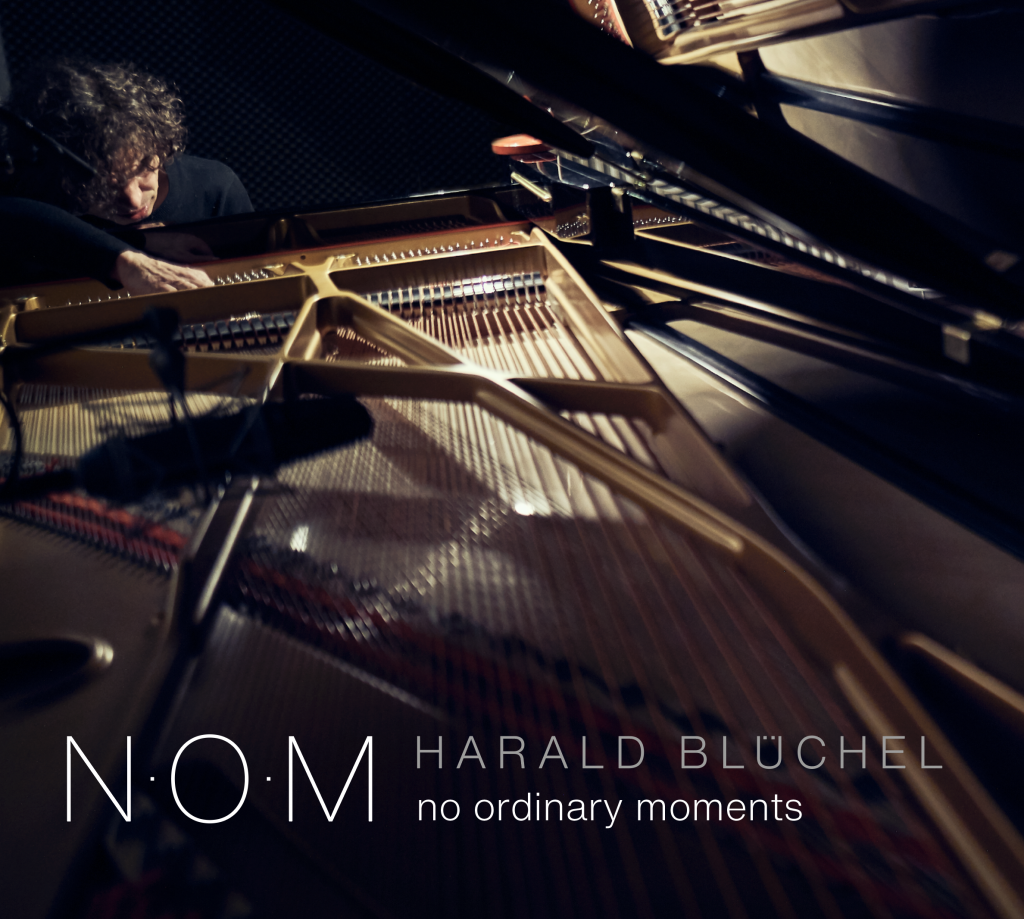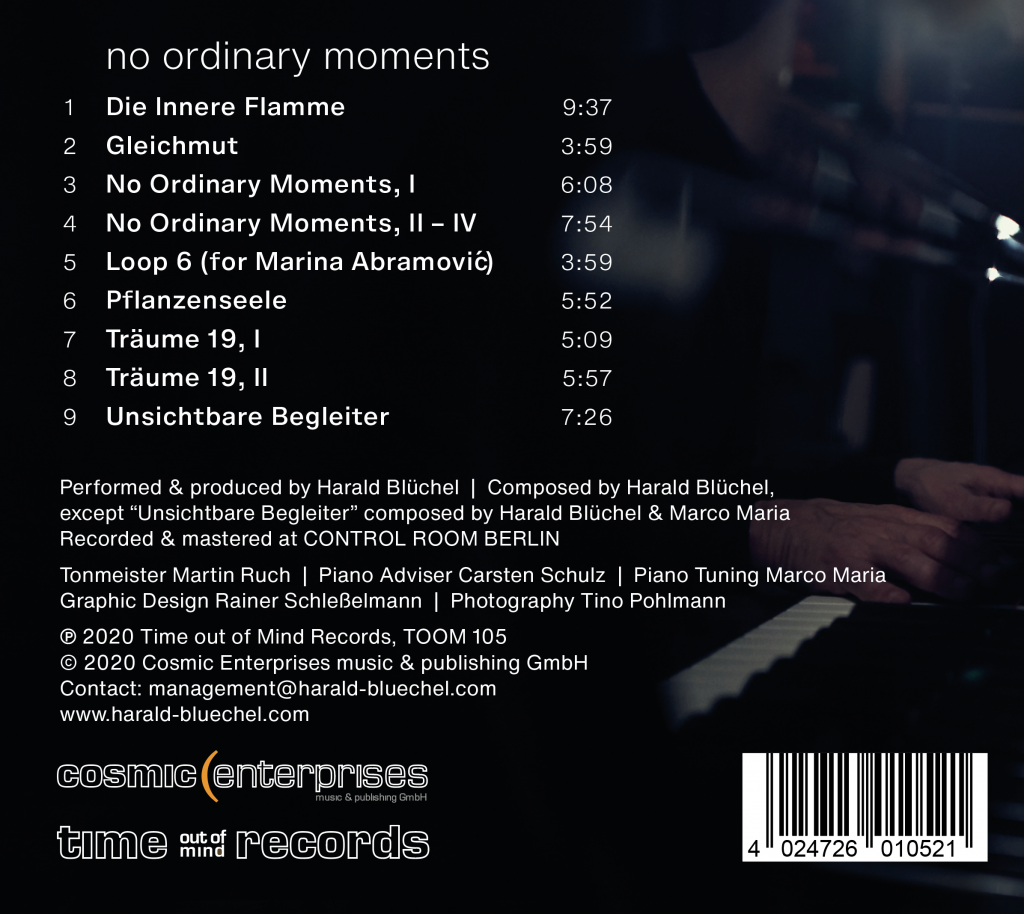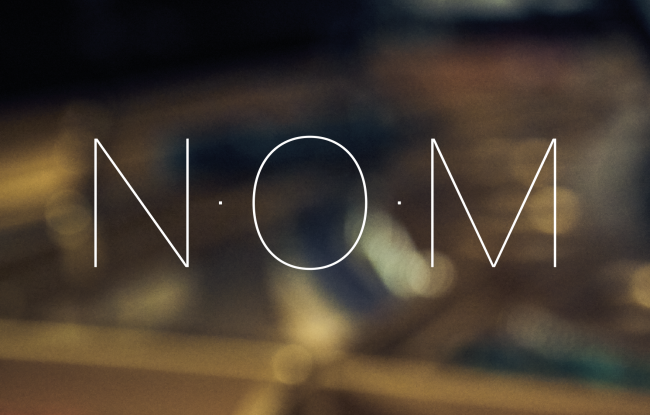

Performed & produced by Harald Blüchel
Composed by Harald Blüchel, except “Unsichtbare Begleiter” composed by
Harald Blüchel & Marco Maria
Recorded & mastered at CONTROL ROOM BERLIN
Tonmeister Martin Ruch
Piano Adviser Carsten Schulz
Piano Tuning Marco Maria
Graphic Design Rainer Schleßelmann
Photography Tino Pohlmann
℗ 2020 Time out of Mind Records
© 2020 Cosmic Enterprises music & publishing GmbH
Contact: management@harald-bluechel.com
TOOM 105
TRACKLISTING
1 Die Innere Flamme 9:37
2 Gleichmut 3:59
3 No Ordinary Moments, I 6:08
4 No Ordinary Moments, II – IV 7:54
5 Loop 6 (for Marina Abramovic) 3:59
6 Pflanzenseele 5:52
7 Träume 19, I 5:09
8 Träume 19, II 5:57
9 Unsichtbare Begleiter 7:26
THOUGHTS
I
About 20 years ago, when let go my career as Cosmic Baby, I initiated a profound change in my life: I wanted to find out whether a life path beyond that of a “high-flyer” and its resulting implications is possible. A concept that is not built around an existence as a musician, but comes from me as a person in its entirety – permeated by a philosophy of life that should be consistently reflected in all aspects of personality and in all areas of life.
The more I got involved in this path, the more resolutely I started to take life personally: I wanted to critically question paradigms and values, experiment with forms, learn, try out, reject, connect things in a –for me- new way.
II
A in my understanding successful life is not about the greatest possible number of horizons and narratives for success in the sense of the prevailing higher-faster-further imperative, but perhaps rather in the conscious decision for the (few) things that are really essential according to the inner compass. To dedicate full concentration and attention to these things – not based on what is “feasible”, on an alleged purpose or constraint, but solely on whether it makes sense, no matter how it turns out, seems to me a good, self-determined basic approach in life design to be.
The more consciously I shape and live my life, the less external factors (which I cannot change anyway) can affect me and the more confident my perception of the world and my relationship to the world develop.
I am more independent and free (of expectations, of values, of material things) and have more time, calmness, energy for what I have decided to do.
The fuel of life is what I call “Die innere Flamme” (“the inner flame”): it comes from attitudes and beliefs, which in turn are emotional and intellectual products of one’s own experiences in combination with our personality-specific possibilities and restrictions. Life is made up of moments of knowledge, surprise, clarity, mindfulness and failure; joy, imagination, disappointment, vulnerability, enthusiasm, courage, tiredness, cowardice, growth and standstill; relief, honesty, illusion and disillusion, inhibition, hatred, faint-heartedness, narrow-mindedness, curiosity, envy and trust; longing, inspiration, interpretation, intuition, arrogance, acceptance, feelings of inferiority, superiority and understanding; Life has to do with hope, belief, doubt, fear, shame, sluggishness, inner freedom and lack of freedom, closeness, love, security, warmth, grief, recognition, tailwind, headwind, crosswind, frustration, aggression, thoughtfulness, will, bitterness, cold, silence, despair, indignation, euphoria, security, insecurity, helplessness, rest, …
III
We all live – at least in this body-mind-space and time configuration – only once. Life is a precious gift, however short or long it may be, and not a cost-benefit calculation in line with the market.
Life is about nothing less than everything:
“It’s about life and death,
Search for meaning and despair,
Love and fear
Longing and loneliness –
for the existence of the world,
that everyone designs for themselves
or into which he sees himself thrown. ” (Eugen Drewermann)
At the end of the imagination horizon there is a recurring notion of being connected to everything with everything and the related responsibility for everything that is living.
Baby steps- attempts to walk in this area could begin with finding the most open and fear-free relationship with yourself and the world.
IV
I stopped dividing my life into outstanding and banal moments and actions. Nothing is self-evident, but what is, that is. I try to give my fullest possible attention to what I have decided at that moment, what is the case at the moment.
This way I stay – as best I can – in the moment. The more attentive I am at the moment (between self-assertion, self-assurance and self-forgetfulness), the greater the possibilities for a self-lived life.
Quality and value are not objectively quantifiable, so they do not lie in the matter itself, but in the subjective contextual relationship that is established with it. The interesting, the surprising, the special lies in the depth, not on its surface and its packaging. This attitude to the world can be practiced anew every day – whether eating, walking, dealing with other people, animals and plants as well as composing, thinking and playing. That is my life practice. And this is how it can be summarized: NO ORDINARY MOMENTS!
Context. Sound. Production
The two pillars on which the compositions of the album are based are my preferences for repetitive – rhythmic pattern structures on the one hand and highly melodic elements in the spirit of classic romanticism on the other.
I describe my style as “minimalist-romantic“.
“Minimalist” because I am strongly influenced by the composers of “minimal music”, because I love patterns and repetition, because I am looking for the greatest possible reduction to the essentials, for perfect simplicity.
“Romantic” because I believe that there is more in the world than what is measurable and what is possible in real politics,
because I see myself as part of a large whole,
because the contact with living beings makes me happier than the promises of the purely material and the virtual world,
because I have not yet given up hope of a fairer, unarmed and nature-conscious world, a world beyond inequality, destruction, NATO and neoliberalism.
When composing, I concentrated on one instrument: the piano.
Karheinz Stockhausen put it this way: “Anyone who composes piano music today, i.e. researches and expands the possibilities of an instrument, a player with his ten fingers and two feet, consciously chooses the virtues of discipline, concentration, simplicity, Subtlety.”
III
Minimalist solo compositions do not make it about the (abundance) of sonic information, but with the most expressive interpretation of the as- little-as-possible that is on the sheet of music.
A lower amount of input shown requires more creative precision, but also enables a higher level of its perception and exploration when listening and greater freedom of interpretation when playing.
In the language of music, it is possible to tell an infinite number of thoughts, feelings and stories intertwined and interpenetrated in a complex simultaneity. A successful composition is poly-subjective in its shaped emotion: it can express the most personal of the composer and at the same time trigger the very own subjective feelings of all other people.
A successful composition can open up spaces, images, associations instead of specifying and defining them.
IV
The wonderful thing about concerts is their uniqueness.
The light, the world from outside, the concentration and energy of each individual in the audience, the grand piano, the sound, the space, my emotional situation flow together into an overall state that will never come back in this same form, constellation and atmosphere: Everyone and everything is actor and re-actor at the same time. Gives and takes. Produces and consumes. Radiates and attracts.
A studio recording, on the other hand, is a frozen moment, a lasting REFERENCE. It compresses a certain period of life and work.
There can be no ideal recording in the studio, but there are endless possibilities in which direction the sound-conceptual journey could go.
When recording No Ordinary Moments, I wanted to record the selected exceptional grand piano (a Fazioli 308) with its infinite shades of sound as directly and precisely as possible. As a result, I wished for an unadorned, subtle, clear sound. For that reason I did without many of the – undoubtedly great – post-processing options today.
I am aware that this fairly puristic and direct approach requires more concentration at the reception than a muted, reverberant sound setting that invites you to lean back: in this production, the listening position is deliberately chosen close to the grand piano rather than in the room.
THE RECORDING SESSIONS IN THE STUDIO – BERLIN/MARCH 2019
The Fazioli 308 grand piano
My favorite instrument is undoubtedly the Bösendorfer 280 VC. Unfortunately, there is not a single one in Berlin. Then I learned about a Fazioli 308, was allowed to play it … and got goose bumps!
So he became my instrument for the studio recordings.
It is always a dialogue between the player and the instrument. Both listen to each other, inspire each other, become one with each other in the most beautiful and best moments.
Sometimes I really heard the Fazioli, that he enjoys going on a trip with me …
When he feels challenged in a beautiful way (quasi dropping his noble silk scarf and rolling up the sleeves of his cashmere pullover) and exploring and transcending sonic limits that his classical self-image has not previously befit him.
World-class grand pianos (Steinway, Bechstein, Bösendorfer) are the finest masterpieces of craftsmanship and sound art. Also the Fazioli belongs to this select club in the piano Olympus.
The Fazioli is an infinitely elegant instrument.
If he was a car, he might be a Lamborghini, an Aston Martin or a Maserati.
I was looking for an instrument that could react extremely sensitively and complexly to my playing. Minimalist solo compositions do not make it over the (over-) abundance of sound information, but in the most expressive articulation of the as little as possible, which is on the sheet music and should be played or heard.
I wanted a very soft, subdued and yet clear basic sound. The instrument should be able to sing that tears come to one, so can give to the most minimal changes of the attack sound differentiated answers.
I was looking for an instrument that can be highly modulated from the slightest fragility to the most extreme borderline areas on the threshold of sounding sound, while maintaining coherence in the overall picture.
I did not want a “Model D – clinical-objective / linear – reference resonance” of a Steinway, but a partner who is committed, who lives permanently sound, surprised me, can take me, if I take him.
Grooving elegance and lively grandeur,
beguiling gentleness in the treble and murderous energy in the bass,
radiantly sovereign transparency and dark sparkling thickets,
Reality on a sensitive scale of one to a thousand.
The Fazioli can do a lot of it. Also because in Martin Ruch I had a gifted sound engineer by my side and in Marco Maria a gifted piano tuner.
I was always surprised, in some moments overwhelmed by his sonic offerings: then it seemed to me that I did not have enough computing power to process and implement all that was flowing into me in the present time.
Imagine a chess player who plays thirty games simultaneously blindfolded. Because you can come to the border area to sweet madness,
where the parallel realities gently begin to collapse and lose their material strength and uniqueness …
With this piano you should live day by day. That does not work, but it’s not that bad, because:
- a) I can do my part by practicing on my instrument at home around him
- b) The next time we meet again for a recording session, we’ll be a bit closer to ear level.
No problem at all: in the concert as in the studio the way goes on and on and on; that’s wonderful and it applies here as in all other aspects of life:
The more to find out, the more there is to know!
In the studio
or:
The difficulty to find the balance from claims to studio reception and living representation
A studio recording is a permanent REFERENCE. It is the documentation of a
reached now-state. It compresses a certain epoch of life. It is a reflected, valid statement. It is an inventory.
Of course, it should reach an optimum of coherence, but without solidifying in over-stylized, over-controlled or over-ambitious perfection. It is very important to keep an eye on all wishes and demands, what you can do and above all, what you just CAN NOT do when it comes to assessing your own abilities as an interpreter.
Incredible but true: Nowadays, in classic hi-end recordings, EVERY BAR is cut and edited to create a TOTALLY flawless and perfect end product.
My concern must be to create a combination and compatibility of these demands and playful lightness, joy, inspiration, experiment, favor of the moment, openness and inner freedom during the sessions.
Pure perfection is machine inviolability, liveliness means human vulnerability. And to be vulnerable, I think you can live that way.
On the one hand, you have sonic ideas in your mind – concepts on how the individual pieces should sound. On the other hand an instrument like the Fazioli offers something that you immediately registered at every second, with what you resonate and what you react.
Sometimes it hits exactly what you want, sometimes something completely different. Then, while you’re playing, you’ll be surprised and in real-time (or later listening) you’ll have to decide whether to let yourself be taken into the unknown new territory, or if you’re trying to come back to your original idea.
Every note, every played sound creates images, colors, memories, mental states, feelings on different meta-levels – all at the same time as well to the motoric processes as the cognitive-conceptual processes.
There can be no absolute ideal recording, but almost endless possibilities of what could be ideal.
In the studio, you go through the entire scale of emotional states:
You experience the moments of absolute calm, intimacy and absorption in the sound.
You experience moments of absolute frustration, despair and helplessness about not getting a piece or passage of a piece the way you want it to.
You experience moments of absolute happiness in the moments in which you meet the “absolutely right” (expression, mood, precision) during playing. Or in the moments where you get the certainty that it fits in the critical listening to a particular take or a cut between different takes in the control room in accordance with the sound engineer!
The studio time in March was an exciting, educational, happy and hard time – all in one. Now I breathe deeply until the final mixes that we will create in early May.

